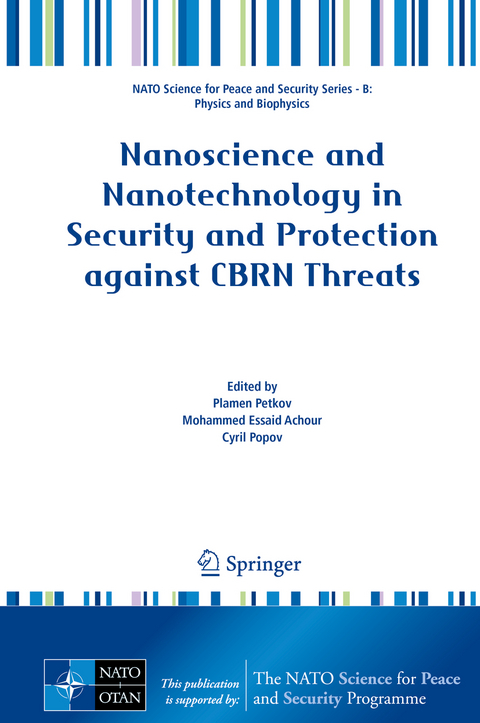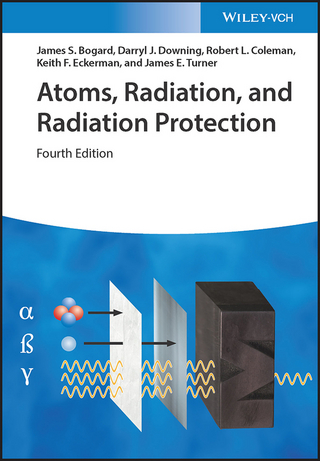
Nanoscience and Nanotechnology in Security and Protection against CBRN Threats
Springer (Verlag)
978-94-024-2044-9 (ISBN)
Plamen Petkov received his degree in Physics from the University of Chemical Technology and Metallurgy, Sofia, Bulgaria in 1981 and his PhD in Physics in 1994. He has worked at postdoc positions in I. Physicalisches Institut, RWTH, Aachen, Germany, University of Odense, Denmark, University of Bonn, Germany. Actually, he is a full professor of applied physics at the University of Chemical Technology and Metallurgy and head of Physics Department and Thin Film Technology Laboratory. His research activity is mainly devoted to electrical and optical properties of semiconductor materials for various technological applications. He is author of more than 170 archival refereed journal papers, co-author and co-editor of 5 books, 10 patents and inventions on topics of solid state physics. Mohammed Essaid Achour received "Thèse de 3ème cycle" from the Bordeaux University, France, and “Thèse d’état” from the Moulay Ismail University of Meknes, Morocco, degrees in field of Physics in 1983 and 1991, respectively. From 1983 to 1992 he was “Maitre assistant” at Sciences Faculty of Meknes, Morocco, “Maitre de Conférence” (1992-1996) and Professor. He joined the Sciences Faculty at Kenitra in 1999. From 1997 to 2011 he was also teacher at the Royal Military Academy at Meknes. His research interests include electromagnetic and electrical properties, microwave characterization and dielectric responses of the composite materials including carbon dots, graphene, carbon nanotubes, carbon black, and natural fibers in the natural or synthetic polymers. He has co-authored more than 90 peer-reviewed scientific papers published in leading refereed journals, 13 book chapters and 6 guest editorials. He was founder and Chair of several editions of the International Symposium on Dielectric Materials and Applications (ISyDMA) and the Moroccan Spring School on Advanced Materials (MoSSAM), and Chair of the Fourth International Meeting on Dielectric Materials (IMDM’4; Marrakech,Morocco, May 2013). Cyril Popov received his MSc in Chemical Engineering in 1990 and PhD in 1994 from the University of Chemical Technology and Metallurgy, Sofia, Bulgaria. In the period 1995-1997 he was a Postdoctoral Fellow at the National Institute of Advanced Industrial Science and Technology (AIST), Tsukuba, Japan and at the Central Laboratory of Photoprocesses, Bulgarian Academy of Sciences, Sofia, working on preparation and investigation of novel materials in the ternary system B-C-N. In 1998 he joined the Institute of Nanostructure Technologies and Analytics (INA), University of Kassel, Germany, where at the present he is a Group leader. His current research interests cover deposition, characterization, nanostructuring and applications of nano- and ultrananocrystalline diamond films and monocrystalline diamond. He is co-author of more than 120 publications, 25 contributions to conference proceedings and 18 book chapters, co-editor of 5 books.
Part I General Topics.- Cyber-Physical Systems to Counter CBRN Threats – Sensing Payload Capabilities in Aerial Platforms for Real-Time Monitoring and Analysis.- Part II Material Preparation and Processing.- Application of Ionizing Irradiation for Structure Modification of Nanomaterials.- The Corona Triode Charging/Polarization System.- Transparent Organic-Inorganic Hybrids Obtained from Covalently Bonded Ureasilicate Monomers: Optical and Mechanical Properties.- Sol-Gel Technique to Design Hybrid Materials and Their Application in Water Purification.- BaTiO3 Structure as a Function of the Preparation Method.- Part III Characterization.- Impedance Spectroscopy: Concepts and Applications.- Undesirable Aspects of Fatigue on Stretchable Elastomer Sensors.- Dielectric Characterization of (Bi1-xFex)NbO4 Ceramics Prepared by Wet-Chemical Route.- Part IV Thin Films.- Study of In2O3 Thin Films Doped with As as Active Layer in Position Sensitive Structures.- Design of Mesoscopic Ordered Titania and Silica Hybrid Sol-Gel Films as Planar Waveguide.- Part V Carbon-based Materials.- CVD Diamond and Nanodiamond: Versatile Materials for Countering a Wide Range of CBRN Threats.- Fabrication of Diamond AFM Tips for Quantum Sensing.- Nanostructured Biochar: Production Pathways and Applications.- Part VI Nanowires and Nanoparticles.- Nanowires for NEMS Switches.- Modification of TiO2 and ZnO Particles Under Mechanical Stress with Polypropylene.- Use of Magnetic Susceptibility Measurement for Analysis of Self-organized Magnetic Nanoparticles in Biological Systems.- Part VII Nanocomposites.- Solvent Dispersible Nanocomposite Based on RGO Surface Decorated with Au Nanoparticles for Electrochemical Genosensors.- Electrical Properties in PMMA/Carbon-Dots Nanocomposite Films Below the Percolation Threshold.- Microwave Characteristics (Reflection Losses) of Composite Materials Consisting of Magnetic Nanoparticles.- Dielectric Properties of PMMA/PPy Composite Materials.- Part VIII Polymer-based Materials.- Recent Advances of Electrospinning and Multifunctional Electrospun Textile Materials for Chemical and Biological Protection.- Temperature Effect on Dielectric Properties of Heterogeneous Material Based on Carbon Black Loaded Copolymer Nanocomposite.- Novel Photocross-Linked Polymers for Construction of Laccase-Based Amperometric Biosensors.- Part IX Oxide and Non-oxide glasses.- Surface Phenomena in Glassy Chalcogenides by Gas Sensing.- Phase Composition and Spectroscopic Characterization of Barium Titanate Containing Glass Ceramics.- Near Infrared Photoluminescence of Nd-Doped ZBP glasses.- Determination of the Surface Properties of Combined Metal-Oxide Layers, Obtained by AC-Incorporation of Ni and Cu in Preliminary Formed AAO Matrices.- Part X Applications: Sensors and Detectors.- Testing of pH Nanosensors Based on Polyaniline/Carbon Nanostructures Coated Screen Printed Electrode.- WO3-Based Glass-Crystalline Sensor for Selective Detection of Ammonia Gas.- PartXI Applications: Water Treatment, Environment and Energy- Optimizing Bacterial Cellulose Production Towards Materials for Water Remediation.- Sodium Ferrites: New Materials to be Applied in Energy Storage Devices in a Wide Frequency Range.- Fluorescent Thin Film Probe for Nitro Compounds: Si Containing Poly[Diphenylacetylene] Case Study.- Determination of Surface Groups of Activated Carbons from Different Sources and Their Application for Heavy Metals Treatment.- Recent Trends of the Use of Rare Earth Elements for Efficient Environmentally Compliant Corrosion Protection of Aluminum and Its Alloys.- Part XII Applications: Health and Biological Threats.- Synthesis of PLGA-PEG-PLGA Polymer Nano-Micelles – Carriers of Combretastatin-Like Antitumor Agent 16Z.- Poly(-caprolactone)/Chitosan Nanostructures for Cell Cultivation.- Preparation and Characterization of Zinc and Magnesium Doped Bioglasses.- Polarized Light for Detection of Pathological Changes within Biological Tissues.- Melanoma Cells Uptake and Hyperthermia Tests of Iron-Based Magnetic Nanoparticles.- Index.
| Erscheinungsdatum | 07.08.2020 |
|---|---|
| Reihe/Serie | NATO Science for Peace and Security Series |
| Zusatzinfo | 246 Illustrations, black and white; XIII, 496 p. 246 illus. |
| Verlagsort | Dordrecht |
| Sprache | englisch |
| Maße | 155 x 235 mm |
| Themenwelt | Naturwissenschaften ► Physik / Astronomie ► Angewandte Physik |
| Naturwissenschaften ► Physik / Astronomie ► Atom- / Kern- / Molekularphysik | |
| Naturwissenschaften ► Physik / Astronomie ► Festkörperphysik | |
| Technik ► Maschinenbau | |
| Schlagworte | Applications • Chemical, Biological, Radiological and Nuclear Tre • Chemical, Biological, Radiological and Nuclear Treats • conference proceedings • cyber security • Materials Science • Nanostructured Materials and Nanotechnologies • Research • Security and Safety |
| ISBN-10 | 94-024-2044-4 / 9402420444 |
| ISBN-13 | 978-94-024-2044-9 / 9789402420449 |
| Zustand | Neuware |
| Haben Sie eine Frage zum Produkt? |
aus dem Bereich


